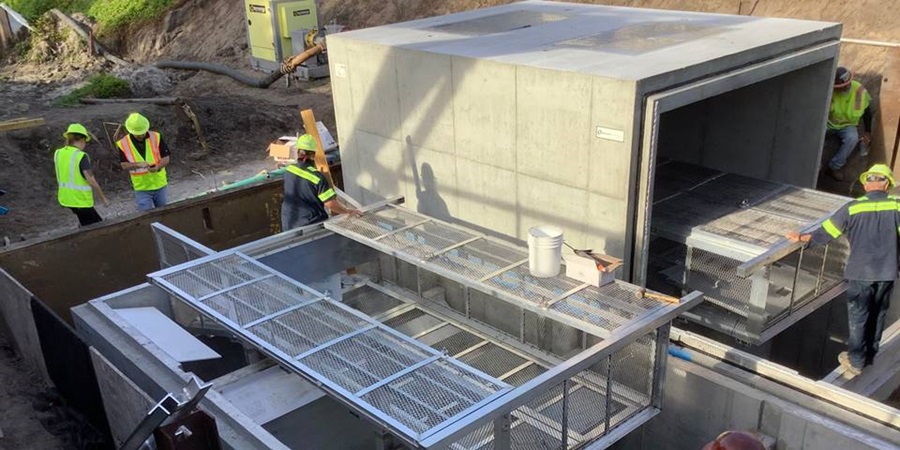August 20, 2024
Indian River Lagoon | Nutrient Separating Baffle Box® (NSBB®)

Stormwater runoff poses increasing challenges to cities, straining sewers and water treatment plants while polluting nearby water bodies. The Indian River Lagoon, located on Florida’s coast southeast of Orlando, is no exception. The 2,284 square miles of this vital watershed generate billions of dollars annually and are key to the region’s economy.
Decades of stormwater runoff containing fertilizers, chemicals, and trash have wreaked havoc along the 156-mile-long Indian River Lagoon. This has resulted in a loss of sea grass, a proliferation of algae, and a threat to the habitat of fish, wildlife, and plant species.
CHALLENGE
The city of Melbourne, FL was in search of a solution to effectively mitigate and clean the stormwater runoff before entering the Indian River Lagoon. Specific challenges during this project included:
• High treatment and peak flows carrying large amounts of trash and pollutants harming the lagoon (Phosphorus, Nitrogen, TSS)
• Site constraints due to right-of-way and accessibility issues
• Aggressive installation schedule coupled with challenging installation conditions
• Designed with simple, accessible maintenance
in mind
SOLUTION
The Melbourne Engineering Department chose to partner with Oldcastle Infrastructure for a long-term solution that fits the parameters of this project.
The Nutrient Separating Baffle Box® (NSBB®) designed and manufactured by Oldcastle Infrastructure, removes trash, sediment, Total Suspended Solids (TSS), and nutrients. NSBB can handle extreme stormwater runoffs like the one on the Indian River Lagoon and offers a superior hydrodynamic separation system that treats the entire flow. The triple-chamber design removes high levels of TSS over a wide range of particle sizes. In addition, patented deflectors ensure no sediment scouring occurs during high flows, allowing for on-line installation without the need for separate diversion structures.
Unlike traditional stormwater treatment methods such as sedimentation ponds, the NSBB is smaller, more flexible and easier to install. Its shallow, small footprint is designed for easier and numerous placements around the lagoon. The engineered concrete product features a multi-stage treatment system with manholes and hinged screen doors. That makes it simple for Melbourne’s Engineering Department to access and maintain 15 baffle boxes, and counting, with one vacuum truck monthly.
“Our need to protect the Indian River Lagoon will only grow,” says Dani Straub, Melbourne Engineering Project Manager. “Our goal is to remove 90,000 pounds of total nitrogen per year and 27,000 pounds of total phosphorus per year. NSBB installations will help us meet that goal.”
BENEFITS
Designed for Easy Maintenance
The NSBB uses a patented screen system to capture and store debris in a dry state to minimize nutrient leaching and allow for efficient maintenance.
Made for a Variety of Application Sites
The NSBB’s innovative design allows for a shallow system in an optimized footprint, allowing it to be installed almost anywhere. The city has installed at least 15 baffle boxes to date and will continue to add more in the coming years.
Built to Capture Pollutants at High Flows
The NSBBs are designed to treat an average of five cubic feet of water
per second. That is more than three million gallons of treated stormwater each year.
Faster Installation Time
With a smaller footprint and a shallow profile, the NSBB is designed for easy installation. Quick installation times have allowed the city of Melbourne to meet its clean water goals within the desired time frame.
Removes Phosphorus and Nitrogen
Incorporating a filtration media in the NSBB allows it to remove more
Nitrogen and Phosphorus, two of the main pollutants that have been of concern to the city of Melbourne. Melbourne’s Engineering Department estimates the baffle boxes have removed more than 7,800 pounds of nitrogen and 1,550 pounds of phosphorus yearly.
_______________________________________________
“Nutrient Separating Baffle Boxes have been a large part of the city’s efforts to clean the stormwater that enters the lagoon. Not only do the baffle boxes trap debris, trash, and pollutants that flow off of streets and into storm drains, they also remove nitrogen and phosphorus, two of the harmful pollutants draining into the Indian River Lagoon.”
Dani Straub
Melbourne Engineering
Project Manager
| Owner
City of Melbourne, FL
| Contractor
Melbourne Engineering Department
| Featured Products
15 – Nutrient Separating
Baffle Boxes (NSBB)